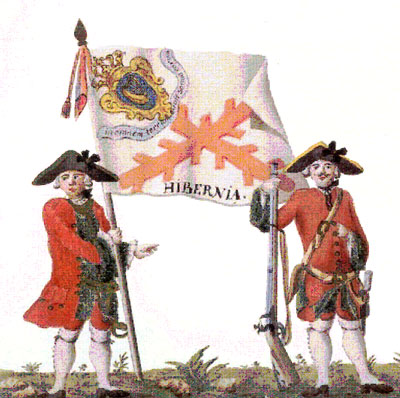|
References
|

Uniform
and colonel’s flag of the Hibernia Regiment,
mid-eighteenth century
(A.
Valdés Sánchez (ed.), Uniformes del Ejército de
Fernando VI. Láminas de la Anne Brown Military
Collection, Brown University Library,
Madrid, 1993) |
-
Andújar
Castillo, Francisco. ‘Familias irlandesas en el Ejército y
en la Corte borbónica’ in García Hernán, Enrique and Óscar
Recio Morales (eds.), Los
extranjeros en los ejércitos españoles (forthcoming
2008).
-
Andújar Castillo, Francisco. El
sonido del dinero. Monarquía, ejército y venalidad en la
España del siglo XVIII (Madrid: Marcial Pons, Ediciones
de Historia, 2004).
-
Archivo General de Simancas (AGS), Guerra Antigua (GA),
Secretaría de Guerra, Cataluña, Libros Generales, Levas. Años:
1648-1686.
-
Archivo General de Simancas (AGS), Guerra Moderna (GM).
-
Bartlett,
Thomas and Keith Jeffery (eds.). A
military history of Ireland (Cambridge, 1996). Re-printed
in 2006.
-
Bueno Correa, José María (ed.). Colección
de cien estampas que demuestra todas las nuevas divisas del Ejército
de España según el último reglamento de este año de 1805
(Madrid, 1986).
-
Recio Morales, Óscar.
Ireland
and the Spanish Empire, 1602–1815. Patterns of Irish
migration, conflict and assimilation
(forthcoming 2008).
-
Serrano Álvarez, José Manuel y Allan J. Kuethe ‘La familia
O’Farrill y la élite habanera’ in Navarro García, L.
(ed.) Élites urbanas en Hispanoamérica (De la conquista a la independencia)
(Seville: Universidad de Sevilla, 2005), pages 203-212.
Notes
[1]
The processes are described in more detail in
Recio Morales
2008.
[2]
Andújar Castillo’s forthcoming study on venality in the
Spanish Army in the Americas promises to be equally
interesting.
[3]
Juan José O’Farrill y Arriola was the son of
Ricardo O’Farrill. This powerful merchant settled in Havana,
Cuba, around 1715 and became involved in the sugar business
and slave-trading. He was named factor
(business manager)
of the Mar del Sur Company around this time. Money and
patronage enabled him to marry the daughter of the Chief
Accountant of the Royal Treasury Court, María Josefa Arriola
y García de Londoño. From then on, the progress of this
Irish dynasty knew no limits. Ricardo O’Farrill had come to
Cuba from the island of Montserrat, where the Irish ran the
slave trade (D.H. Akenson, If
the Irish ran the world. Montserrat, 1630-1730: 1997). He
appears in some documents as a native of Ireland and in others
as a native of Montserrat. He attained Spanish citizenship by
royal decree on 17 January 1722 (José Manuel Serrano Álvarez
y Allan J. Kuethe, ‘La familia O’Farrill y la élite
habanera’, in L. Navarro García (coord.), Élites
urbanas en Hispanoamérica (De la conquista a la
independencia) (2005), pages 203-212).
[4]
For O’Reilly’s doubts about the place-buying system see
Andújar Castillo 2004: 320-328. |


